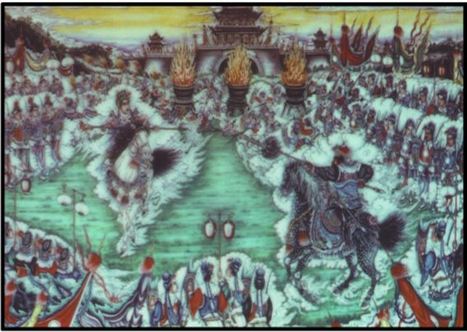China Han Dynasty Biography Activity #8 Soldiers

Soldiers played an important role during the Han dynasty. During the early years of Han rule, enemies from the north constantly threatened China. The emperor frequently called on his army of soldiers to defend the empire. Later, Han rulers used the army to expand their empire. During the period from 140 to 87 BCE, soldiers captured lands in southern China and started colonies there. Han troops also crossed the Great Wall and the huge Gobi desert to the north. They defeated the raiding tribes from this region and brought the people under Chinese rule.
All Han men in good health and between the ages of 23 and 56 had to serve in the army. This service lasted for two years. After this period, the men could be recalled to the army at any time if the emperor declared an emergency. Soldiers spent the first part of their service in training. They spent the next part of their service stationed inside China on China’s distant frontiers. Soldiers in the Han army received basic allowances, or rations, of food, clothing, and equipment. They were not, however, paid for their service.
During Han times, a large corps of foot soldiers, or infantry, made up the main part of the army. An advance guard of archers with bows and arrows and horsemen, or cavalry, supported the infantry. In earlier times, soldiers on horse-drawn battle cars, or chariots, had been an important part of the fighting army. During the reign of the Han, large regiments of cavalry replaced the chariots in battle. The cavalry was faster because the horses could move along uneven ground and required only one rider. However, the chariot remained a symbol of authority and continued to be used by officers.
The Han infantry wore full uniforms. Soldiers wore knee-length gowns, leg wrappings called puttees, square-toed sandals, and protective armor that covered the upper body. Archers had similar uniforms, except they wore pants instead of puttees. A soldier’s armor was made of a combination of metal and leather plates secured by bolts and cords. Square or rectangular iron plates fitted tightly to the chest and back, and movable leather plates covered the shoulders, stomach, and neck. An officer’s uniform was made of a finer quality and were extended in front like a kind of apron. Decorations on their uniforms showed their officer status.
Han soldiers used a variety of weapons. Infantry commonly used spears, knives, or crossbows. The crossbow fired a solid missile-shaped object and was more powerful and accurate than standard bows and arrows. Most weapons were made of bronze, with a few made of iron. The infantry did not normally use swords, but some officers and cavalrymen did carry them.
The Han government appointed experienced soldiers to lead military battles. These officers might command troops from several provinces. For minor battles, the government might appoint a junior officer to lead the forces. For major battles, the government appointed one commander-in-chief and several general officers.
All Han men in good health and between the ages of 23 and 56 had to serve in the army. This service lasted for two years. After this period, the men could be recalled to the army at any time if the emperor declared an emergency. Soldiers spent the first part of their service in training. They spent the next part of their service stationed inside China on China’s distant frontiers. Soldiers in the Han army received basic allowances, or rations, of food, clothing, and equipment. They were not, however, paid for their service.
During Han times, a large corps of foot soldiers, or infantry, made up the main part of the army. An advance guard of archers with bows and arrows and horsemen, or cavalry, supported the infantry. In earlier times, soldiers on horse-drawn battle cars, or chariots, had been an important part of the fighting army. During the reign of the Han, large regiments of cavalry replaced the chariots in battle. The cavalry was faster because the horses could move along uneven ground and required only one rider. However, the chariot remained a symbol of authority and continued to be used by officers.
The Han infantry wore full uniforms. Soldiers wore knee-length gowns, leg wrappings called puttees, square-toed sandals, and protective armor that covered the upper body. Archers had similar uniforms, except they wore pants instead of puttees. A soldier’s armor was made of a combination of metal and leather plates secured by bolts and cords. Square or rectangular iron plates fitted tightly to the chest and back, and movable leather plates covered the shoulders, stomach, and neck. An officer’s uniform was made of a finer quality and were extended in front like a kind of apron. Decorations on their uniforms showed their officer status.
Han soldiers used a variety of weapons. Infantry commonly used spears, knives, or crossbows. The crossbow fired a solid missile-shaped object and was more powerful and accurate than standard bows and arrows. Most weapons were made of bronze, with a few made of iron. The infantry did not normally use swords, but some officers and cavalrymen did carry them.
The Han government appointed experienced soldiers to lead military battles. These officers might command troops from several provinces. For minor battles, the government might appoint a junior officer to lead the forces. For major battles, the government appointed one commander-in-chief and several general officers.
